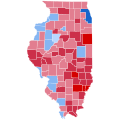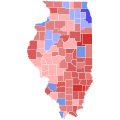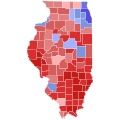Top Qs
Timeline
Chat
Perspective
Political party strength in Illinois
Politics in the US state of Illinois From Wikipedia, the free encyclopedia
Remove ads
Illinois is a Democratic stronghold in presidential elections and one of the "Big Three" Democratic strongholds alongside California and New York. It is one of the most Democratic states in the nation with all state executive offices and both state legislative branches held by Democrats.[1][2] For most of its history, Illinois was widely considered to be a swing state, voting for the winner of all but two presidential elections in the 20th century. Political party strength in Illinois is highly dependent upon Cook County, and the state's reputation as a blue state rests upon the fact that over 40% of its population and political power is concentrated in Chicago, Cook County, and the Chicago metropolitan area. Outside of Chicago, the suburban collar counties continue trending Democratic[3] while downstate Illinois can be considered more conservative with several Democratic leaning regions including Champaign-Urbana, Bloomington-Normal, Rockford, Peoria, the Quad Cities, and suburban St. Louis.[4]
Illinois's electoral college votes have gone towards the Democratic presidential candidate for the past eight elections, and its congressional makeup tilts heavily Democratic with a 14-3 majority as of 2025. However, it has a history of competitive statewide elections and has elected a small number of moderate Republicans including Governors Jim Edgar, George Ryan, and Bruce Rauner, Senators Peter Fitzgerald and Mark Kirk, and other state executive officeholders including Judy Baar Topinka and Dan Rutherford.
The following table indicates the party of elected officials in the U.S. state of Illinois:
- Governor
- Lieutenant Governor
- Secretary of State
- Attorney General
- Comptroller (Auditor before 1972)
- Treasurer
The table also indicates the historical party composition in the:
Remove ads
Table
- The Office of Illinois Auditor of Public Accounts existed from 1818-1973, when it was eliminated by the 1970 Constitution and replaced with the office of Comptroller. George W. Lindberg was the first Illinois Comptroller
- Territorial governor appointed by the President of the United States.
- Delegate to the U.S. House of Representatives from Illinois Territory.
- Resigned following election to United States House of Representatives.
- Elected a Democrat, William Lee D. Ewing, as a minority-party Speaker.
- An Anti-Nebraska Democrat, Thomas J. Turner, was elected in coalition with the Whigs to be a minority-party Speaker.
- Resigned so that Lieutenant Governor John Lourie Beveridge, acting as governor, would appoint him to the United States Senate.
- Due to the ascension of Lt. Gov. Beveridge to the Governorship after Gov. Oglesby took a U.S. Senate seat, the President Pro Tempore elected by the Senate, John Early, became acting Lt. Governor.[5]
- A coalition of Democrats and Independents organized the Senate, and chose Archibald A. Glenn, a Democrat, to be President Pro Tempore. Due to the vacancy in the Lt. Governorship from John Beveridge ascending to be Governor in 1873, Glenn also became acting Lt. Governor.[5]
- A coalition of Democrats and Independents organized the House, and chose Elijah Haines, a Independent, to be Speaker.[5]
- Resigned to take an elected seat in the United States Senate.
- A coalition of Democrats and Independents organized the Senate, and chose Fawcett Plumb, an Independent tied to the Farmers' Association, to be President Pro Tempore.[5]
- The Independent, Elijah Haines, was elected Speaker with Democratic support, giving them control.
- After 76 ballots, a Democrat, William B. McKinley, was elected Speaker with Republican votes.[6]
- Resigned to take seat on the United States Court of Appeals for the Seventh Circuit.
- Removed from Office upon tax fraud conviction.[7]
- The Independent, Taylor Pouncey, caucused with the Democrats, giving them the votes to control the Speakership and run the House.[8]
- Impeached and removed from office by the state legislature on corruption charges.
- Resigned following election as president of the United States.
- Regarding resignations and appointments; the person who held the office for the majority of the year is listed as the office holder for that year.
Remove ads
Gallery
Gallery of Illinois presidential election results
- Illinois in the 2000 presidential election. Gore v. Bush.
- Illinois in the 2004 presidential election. Kerry v. Bush.
- Illinois in the 2008 presidential election. Obama v. McCain.
- Illinois in the 2012 presidential election. Obama v. Romney.
- Illinois in the 2016 presidential election. Clinton v. Trump.
- Illinois in the 2020 presidential election. Biden v. Trump.
- Illinois in the 2024 presidential election. Harris v. Trump.
Gallery of Illinois US Senate election results
- 2004 US Senate election results.
- 2008 US Senate election results.
- 2010 US Senate election results.
- 2014 US Senate election results.
- 2016 US Senate election results.
- 2020 US Senate election results.
- 2022 US Senate election results.
Gallery of Illinois gubernatorial election results
- Illinois gubernatorial race in 2002
- Illinois gubernatorial race in 2006
- Illinois gubernatorial race in 2010. Notice that Pat Quinn won while carrying the same counties as losing Democratic Senate candidate Alexi Giannoulias.
- 2014 Illinois gubernatorial election. Incumbent Democratic governor Pat Quinn was defeated for reelection by Republican candidate Bruce Rauner. Notice that Rauner carried every county except Cook County.
- 2018 Illinois gubernatorial election. Strong Democratic turnout in Chicago, Cook County, all of the suburban collar counties, and modest growth in downstate support (mainly in the smaller cities) drove J. B. Pritzker's decisive victory.
- 2022 Illinois gubernatorial election. Results were very similar to 2018.
Remove ads
See also
References
Wikiwand - on
Seamless Wikipedia browsing. On steroids.
Remove ads



















